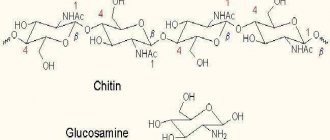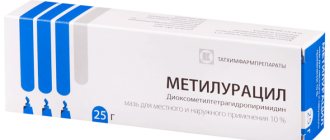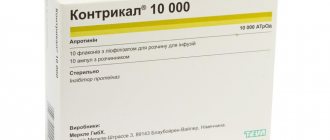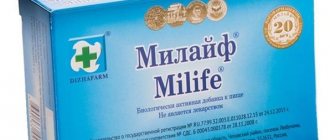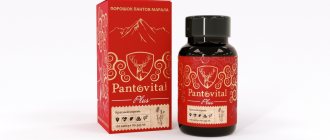Lysozyme - what is it? This substance is a naturally occurring drug with antimicrobial and antiparasitic effects and belongs to a class of enzymes called “hydrolases.” This enzyme was discovered in chicken protein in 1909 by Pavel Nikolaevich Lashchenkov, and subsequently in 1922 Alexander Fleming named this substance lysozyme.
The main active ingredient of the drug is lysozyme hydrochloride, a proteolytic enzyme obtained from chicken egg white. The relative molecular weight is about 15 thousand grams/mol. According to the instructions for use, this medicine, when released, is a sterile lyophilisate, a white porous mass or a white amorphous powder with a faint odor of vinegar.
The sources of lysozyme content are: tear fluid, breast milk, saliva, spleen and liver, gastrointestinal mucosa, nasopharyngeal mucosa. Thus, in saliva and other mucous membranes, this enzyme performs a protective function , helping to prevent harmful agents from entering the body.
Pharmacological action of the drug
The antibacterial, anti-inflammatory and mucolytic properties of the drug are due to its composition. Antibacterial pharmacological action
lysozyme appears due to the destruction of the walls of bacterial microorganisms, due to this the dissolution of bacterial cells occurs and their complete destruction.
In addition, lysozyme hydrochloride helps stimulate the body's reactive forces, and also increases the effectiveness of various antibiotics, since it has the ability to actively interact with them.
Regenerating and analgesic properties are also observed.
lysozyme, in particular, in the treatment of gastric and duodenal ulcers. Treatment of burns with lysozyme promotes the rapid release of tissue from necrotic masses and epithelization of wounds.
Due to the lack of toxicity, the drug is often used as part of complex therapy. The maximum concentration of the drug after entering the body is achieved after one and a half hours.
Drug interactions
Lysozyme is a lozenge that, when used in recommended doses, practically does not interact with other drugs of concomitant therapy. When used together, lysozyme enhances the pharmacological activity of antibiotics and nitrofurans, including penicillin, chloramphenicol, nitrofurantoin.
After the time specified in the instructions has expired, during which it is undesirable to drink liquids and eat food, it is recommended to supplement the course of treatment with other drugs for topical use.
These include herbal infusions for rinsing, disinfectants in the form of oil mixtures and solutions. In this case, the surface of the mucous membranes will be frequently and intensively cleansed of bacterial metabolic products and their decay. As a result, the treatment process will be reduced to a minimum period.
Mode of application
The use of lysozyme is indicated for the following diseases:
Lysozyme can be used in 2 ways:
- locally;
- intramuscularly,
At the same time, the choice of method of application is influenced by the type and complexity of the skin disease.
In ophthalmological practice
This drug is used in the first way in the form of installations, namely: instilled into the eyes at least 3 times a day, the duration of the course of this procedure is from 3 to 6 days.
Therapy of ENT diseases involves the use of this medication in the form of inhalation
. The amount of the drug used in 1 session is approximately 2-10 ml, and the duration of treatment should be at least 5-14 days.
If lysozyme is necessary for the treatment of frostbite and burns
or for the treatment of purulent wounds, it is used in the form of applications as follows: moisten a sterile napkin in a solution of the drug (0.05%) and apply it to the affected area of the skin. This bandage must be applied every day or once every 2 days; the frequency of dressing is affected by the severity of the lesion.
Intramuscular injections
it is required to produce 3 times 100-150 mg per day. The duration of such therapy should be at least 7-10 days. If necessary, the course can be extended for a month, but this will require constant monitoring of blood counts.
In addition to the above methods of use, lysozyme can be used as a means in which various incubation tubes, bandages, tampons are soaked for subsequent use, for example, when preparing a patient for surgery or after anesthesia.
In addition, lysozyme can be used in conjunction with other drugs to increase the effectiveness of their pharmacological action, which makes it possible to have a positive effect on the body’s immune system weakened by disease.
It is worth noting that lysozyme is widely used not only in pharmaceuticals, but also in the food industry as a preservative.
, in the production of some fermented milk products, as well as in the production of cosmetic products.
Contraindications and side effects
Since lysozyme hydrochloride has good tolerability and low toxicity
, this product does not have any contraindications. However, it should be used only as prescribed by a doctor, since an allergic reaction is still possible if there is hypersensitivity to such a drug.
As a side effect of the use of lysozyme, in rare cases, a hypersensitivity reaction occurs. And prolonged intramuscular administration of the drug can lead to blood clotting disorders.
Among the precautions, it is worth mentioning the undesirability of combining lysozyme with alcoholic beverages and alcohol-containing preparations. Also, when carrying out the eye drop procedure, you should refrain from driving a vehicle for at least 15-20 minutes.
As for the prescription of drugs containing lysozyme hydrochloride to pregnant
women
, there are no contraindications for their use. However, it is worth considering that such a drug can cause an allergic reaction, to which a woman’s body is especially susceptible during pregnancy.
Storage conditions
Lysozyme must be stored away from direct sunlight.
where there is no high humidity. The optimal storage temperature is not exceeding 20 °C. The expiration date of the drug must be indicated on the packaging. The drug should be kept away from children and animals.
The average cost of this product is about 280-350 rubles.
Before purchasing it, you should definitely consult with your doctor, since only he can correctly determine whether the drug is necessary and determine the procedure for its use.
Contained in leukocytes, egg whites, skin, mucous membranes and some body fluids (saliva, tear fluid). Lysozyme breaks down mucopolysaccharides, which form the structural basis of the cell wall, thereby causing lysis of bacteria. Lysozyme protects the mucous membranes of the eye, mouth, intestines and nasopharynx from infection.
Lysozyme (muramidase) is an enzyme that has the specific ability to cause the dissolution of certain microorganisms. Fleming (A. Fleming) combined bacteriolytic protein substances of various origins into the group of “lysozymes”.
In humans, lysozyme is found in tears, sputum, saliva, blood serum and plasma, in human milk, in the nasal mucosa, spleen, liver, bone marrow, cartilage, omentum, leukocytes, heart, intestinal and pancreatic extracts. Lysozyme is found in plants (horseradish, radish, turnip, cabbage, primrose), some bacteria and viruses (bacteriophages). Macrophage lysozyme is involved in the intracellular digestion of microbes. The content of lysozyme in animal and plant objects varies widely. Its highest concentration is found in chicken egg white, horseradish and tears. Isolation of the enzyme is based on its ability to adsorb on bentonite clay, followed by elution with acidified pyridine (pH=5.0).
Lysozyme has been obtained in crystalline form from various sources. Its physicochemical properties and lytic activity vary widely. Mol. the mass of lysozyme of animal origin is 14,800, from plants - 24,000, from bacteriophage - 13,900. Lysozyme is one polypeptide chain consisting of 130-150 amino acid residues; does not contain sulfhydryl groups; resistant to heating up to 100° in an acidic environment.
The activity of lysozyme is determined by the degree of lysis of a highly sensitive micrococcus (Micrococcus lysodeikticus). Gram-positive microbes are sensitive to lysozyme, while gram-negative ones are resistant. The mechanism of action of lysozyme is reduced to enzymatic cleavage of the rigid murein layer of the bacterial cell wall, which is accompanied by the release of muramic, diaminopimelic, glutamic and aspartic acids, glucosamine, alanine, serine and lysine. As a result of this, the cell takes on the shape of a ball (protoplast) and retains it in a hypertonic environment, but ruptures in an iso- or hypotonic environment (see Bacteriolysis). Thus, with the help of lysozyme, important information about the anatomy of the bacterial cell was obtained. Lysozyme is used in the food industry for canning (for example, caviar). See also Enzymes.
Lysozyme is a drug with anti-inflammatory and bacteriolytic effects.
Lizobakt during pregnancy
The use of the medicine is permitted throughout the entire period of pregnancy: from the first trimester until childbirth. It is especially important for pregnant women to know which drug can safely protect against the spread of infection in case of upper respiratory tract disease. Your own saliva, which contains lysozyme, may be produced in insufficient quantities, because many expectant mothers are prohibited from drinking a lot of liquid due to edema.
In addition, altered hormonal levels during pregnancy can have an inhibitory effect on the functioning of the salivary glands. Lyzobact will easily compensate for the lack of natural lysozyme, which effectively copes with its antiseptic properties without harming the unborn child.
Directions for use and dosage
Lysozyme is used topically or intramuscularly.
Before use, the drug contained in the bottle should be dissolved in 2-3 ml of 0.25% novocaine solution or isotonic sodium chloride solution.
Locally, Lysozyme is used in ophthalmic practice in the form of installations with a 0.25% solution. Frequency of use – 3-4 times a day, duration of therapy – 3-7 days.
In otorhinolaryngological practice and for the treatment of chronic nonspecific lung diseases, aerosols of a 0.05% solution are used. Per session – 2-10 ml, duration of therapy – 5-14 days.
To treat purulent wounds, frostbite and burns, wipes soaked in a 0.05% solution should be applied.
Lysozyme is administered intramuscularly 2-3 times a day, 150 mg for at least 7 days. Duration of therapy is up to 1 month.
Compound
Each tablet contains the following substances:
| lysozyme | 20 mg |
| pyridoxine | 0.1-0.3 mg |
| pantothenic acid | 1.2 mg |
In addition to the active ingredients, the composition includes excipients:
- gum tragacanth;
- milk sugar;
- flavoring;
- Mg stearate.
Some preparations with lysozyme do not contain pantothenic acid.
Terms and conditions of storage
Store in a place protected from light, out of reach of children at temperatures up to 20 °C.
Name:
Lysozyme
Pharmachologic effect:
The drug has a bacteriolytic (bacteria-destroying) effect. Has the ability to destroy polysaccharides of the microbial membrane. Suppresses the growth of gram-positive bacteria; gram-negative bacteria are less sensitive to it. Along with antibacterial properties, the drug has the ability to stimulate nonspecific reactivity of the body, have an anti-inflammatory and mucolytic (thinning) effect.
Indications for use:
Lysozyme is used in the treatment of chronic septic (associated with the presence of microbes in the blood) conditions and purulent processes, for burns, frostbite, conjunctivitis (inflammation of the outer membrane of the eye), corneal erosions (superficial defect of the transparent membrane of the eye), aphthous stomatitis (inflammation of the oral mucosa with the formation of its surface defects) and other infectious diseases. The drug is non-toxic, does not irritate tissues and can be used if other antibacterial drugs are poorly tolerated.
Method of application:
Apply topically, sometimes intramuscularly. Before use, dissolve the lysozyme contained in the bottle in 2-3 ml of isotonic sodium chloride solution or 0.25% novocaine solution.
A 0.25% solution is used locally in ophthalmic practice in the form of installations (instillations) 3-4 times a day for 3-7 days. In the treatment of chronic nonspecific lung diseases and in otorhinolaryngological practice (treatment of diseases of the ear, nose and throat), aerosols of a 0.05% solution are used, 2-10 ml per session, the course of treatment is 5-14 days.
To treat burns, frostbite and purulent wounds, wipes moistened with a 0.05% solution are applied.
150 mg is administered intramuscularly 2-3 times a day for at least 7 days. If necessary, continue administration for up to 1 month.
Adverse events:
The drug is usually well tolerated. With prolonged intramuscular administration (for chronic infections), blood clotting should be monitored.
Release form of the drug:
In hermetically sealed bottles containing 50, 100 or 150 mg of lysozyme. Solutions are prepared extempore (before use).
Storage conditions:
In a dry, dark place at a temperature not exceeding +20 °C.
Synonyms:
Mucopolysaccharidase.
Compound:
Enzyme of protein nature (relative, molecular weight about 15,000).
For use as a medicinal product, it is obtained from chicken egg whites.
Drugs with similar effects:
Eucalyptus-M Vagical Phytodent Neo-angin Malavit
Dear doctors!
If you have experience in prescribing this drug to your patients, share the result (leave a comment)!
Did this medicine help the patient, did any side effects occur during treatment? Your experience will be of interest to both your colleagues and patients. Dear patients!
If you were prescribed this medicine and completed a course of therapy, tell us whether it was effective (helped), whether there were any side effects, what you liked/disliked.
Thousands of people search the Internet for reviews of various medications. But only a few leave them. If you personally do not leave a review on this topic, others will have nothing to read. Thank you very much!
Lysozyme is an enzyme found in leukocytes, egg whites, skin, mucous membranes and some body fluids (saliva, tear fluid). To produce a drug with the same name, an enzyme contained in the white of chicken eggs is used.
Lysozyme is an antibacterial drug of natural origin, used intramuscularly (for intramuscular administration) and topically. It has the ability to destroy the structural basis of the cell of pathogenic microorganisms, which determines its antibacterial (antibiotic) effect. This process is carried out by hydrolysis of the enzyme murein or peptidoglycan, which is part of the cell walls of microorganisms.
The drug is active against gram-positive and, to a lesser extent, gram-negative microorganisms. In addition, Lysozyme has immunomodulatory, thinning and anti-inflammatory properties. The drug is non-toxic, does not irritate tissues and can be used if other antibacterial products are poorly tolerated.
Lysozyme photo
The product is available in the form of a sterile lyophilized powder for the preparation of a suspension in bottles of 0.05, 0.15 and 1 g and is used in medicine mainly as a local antiseptic drug. Amorphous powder or porous mass of white color with a faint odor of acetic acid. Slightly soluble in water; practically insoluble in alcohol; pH of 2% solution is 4.2 - 5.5.
Indications for use Lysozyme
Lysozyme is prescribed for the treatment of various purulent, septic, infectious and inflammatory diseases. Most often, the medicine is prescribed in combination with antibiotics.
The use of this medicine is indicated for pneumonia and bronchopulmonary diseases, as well as for:
- chronic hepatitis;
- purulent skin lesions;
- conjunctivitis;
- diseases of the ENT organs;
- stomatitis, gingivitis, pulpitis;
- burns, frostbite, bedsores and corneal erosion;
- allergic blepharokeratitis.
In ENT practice and dentistry, lysozyme hydrochloride is often used in combination with substances such as enoxolone (Hexaliz) and dequalinium chloride (Laripront, Lizak).
To prevent post-intubation complications during endotracheal anesthesia, lysozyme is used before and after anesthesia in the form of an aerosol of 3 ml of a 0.05% solution; inhalation duration is about 3 minutes. In addition, the endotracheal tube and bandage for tamponade of the oral cavity and pharynx are treated with the same lysozyme solution.
Instructions for use Lysozyme, dosage
150 mg is administered intramuscularly 2-3 times a day for at least 7 days. If necessary, continue administration for up to 1 month.
Before use, the powder is diluted in 3 ml of 0.5% sodium chloride or novocaine solution.
When treating eyes, in most cases a 0.5% solution is used. They are instilled into the eyes three times a day for seven days.
In the treatment of chronic nonspecific lung diseases and in otorhinolaryngological practice (treatment of diseases of the ear, nose and throat), aerosols of a 0.05% solution are used, 2-10 ml per session, the course of treatment is 5-14 days.
For burns, frostbite and purulent wounds - topically, by applying sterile napkins moistened or soaked in a 0.05% solution of lysozyme.
In dentistry, a 0.1% solution of lysozyme in an isotonic sodium chloride solution is used to treat the root canals of teeth, as well as for application or irrigation of lesions of the oral mucosa, 3-4 times a day after meals.
Features of application
There is no information regarding the use of the drug by pregnant and lactating women. It is better to find out about the possibility of using the drug in some cases from your doctor and pediatrician.
The drug does not affect alertness and concentration, but when instilling eye drops, it is advisable to refrain from driving for 15-20 minutes.
Pharmacodynamics
Pharmacologically, lysozyme belongs to antibacterial agents - enzymes of the hydrolase subclass. The therapeutic activity consists of the destruction of the cell walls of bacterial bodies. This occurs as a result of the hydrolysis of peptidoglycans - heteropolymers of N-acetylglucosamine and N-acetylmuramic acid, connected by lactate particles of chains of peptides.
Under natural conditions, lysozyme is found in the highest concentration in saliva, which explains its antimicrobial properties, nasopharyngeal mucus, tear fluid and on the inner lining of the gastrointestinal tract. During breastfeeding, the body secretes lysozyme along with breast milk.
At the same time, the concentration begins to increase six months after the birth of the child for natural reasons in order to prevent infection of the developing baby.
Pyridoxine, which is also part of the drug, helps stimulate regenerative processes on the mucous membranes of the oral cavity and accelerates the restoration of damaged epithelium.
Side effects and contraindications Lysozyme
Lysozyme is generally well tolerated; only in some cases allergic reactions to the drug have been reported. Long-term intramuscular use of Lysozyme requires control of blood clotting.
Overdose
No cases of overdose have been identified.
Contraindications
Lysozyme is contraindicated for use in cases of hypersensitivity to lysozyme hydrochloride. However, it is worth noting that allergic reactions when using the drug occur in very rare cases.
Analogues of Lysozyme, list
- Strepsils;
- Chlorophyllipt;
- Mucopolysaccharidase.
Important - instructions for use of Lysozyme, price and reviews do not apply to analogues and cannot be used as a guide to the use of drugs of similar composition or action. All therapeutic prescriptions must be made by a doctor. When replacing Lysozyme with an analogue, it is important to consult a specialist; you may need to change the course of therapy, dosages, etc. Do not self-medicate!
This drug should not be used independently; it is sold in pharmacies strictly according to the prescription. When using, be sure to consult a doctor to avoid unwanted consequences that may affect your health.

